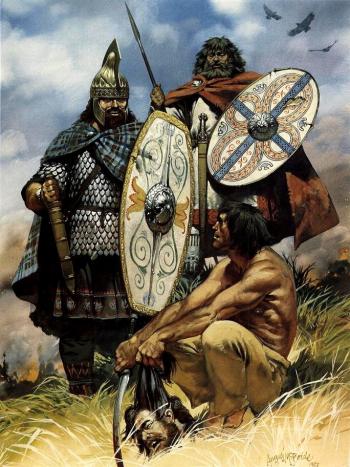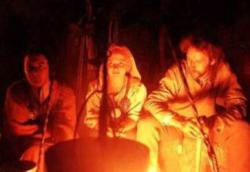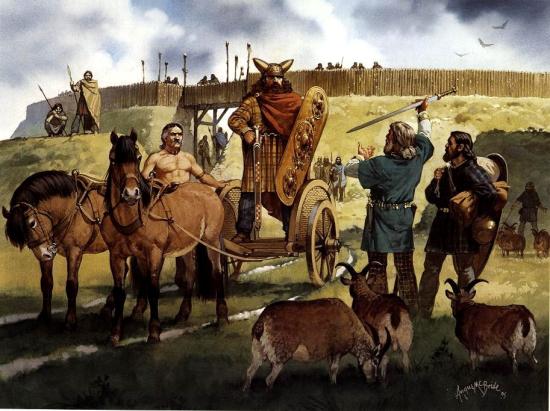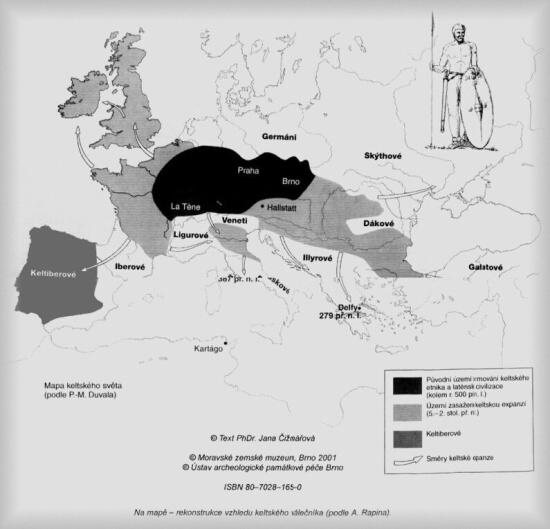Viky prosba: nedávno mě kámoš vytáhnul na paintboll... (nevím zdali gute schreiben...)o to nejde ocitli jsme se na hradišti jménem bozeň též šance u Březnice ve stř. Čechách... nedalo by se zjistit něco více o tomto místě? má zajímavý způsob opevnění dvojitých hradeb těžko překonatelných...díky. P.S. díry nejsou pozůstatky paintb.hráčů i když na toto posv. místo také asi nepatří šlo to mimo mě... zjistil jsem to až na vrcholu jasnou cedulí...
History of the Celts in Bohemia
Categories: What didn't fit elsewhere

Nowadays, it is already scientifically proven that the cradle of the Bohemians is also western Bohemia together with the Upper Danube region. After that, they probably expanded both to the east and especially to the west and also to the south. Evidence for this comes from finds that directly point to a settlement by one ethnic group, which would have been the so-called Proto-Celites; this settlement would have lasted for more than a thousand years.
If we go back to the earlier Bronze Age, we learn that the area of the Bohemian Basin was very rarely inhabited. We could find here mainly the Unetic culture (central and north-western Bohemia). The beginning of major resettlement began between 1500 and 1200 BC, i.e. in the Middle Bronze Age. In this decade, southern Bohemia was settled by the Middle Danube Mound Culture and central and north-western Bohemia by the Falck Mound Culture. These were mainly hunters and warriors, which is evident from the mound graves found in which important people were buried. Among the finds were mostly weapons - bronze swords and daggers, bows and arrows with bronze tips. Women wore gold bracelets, rings, necklaces and earrings. Razors and tweezers have also been found in graves where men were buried. However, they had probably brought these riches from their homeland. The pottery, however, was very poor and poorly made for that time, and did not exhibit any peculiar shapes.

The culture of the people of the ash fields prevailed in north-east Bohemia. The main area they were involved in was agriculture. A small number of bronze objects with which they traded have been found. The pottery here was at a similar level to that in other places, purposeful, without significant decoration. The difference was that their society was more advanced. They lived in open villages and even built forts - the first in our territory. They created a whole system of fortress settlements. These forts can be found in Mašov, Poran u Vesce, Nové Město nad Metují, Doudleb, Lžovice u Kolín, etc. They were very well built fortifications, actually fortresses with ramparts, ditches, palisades and storehouses. These structures became the model for later oppida. We are still talking about the ancestors of the Celtic ethnicity.

But now to the Celts themselves...
This nation was born north of the Alps. Interestingly, although it was a Celtic nation from the 4th century BC. and was the most powerful nation in western and central Europe, it never formed a unified state or empire. The Greeks were the first to call them Keltoi, a name that was adopted for all the people. The Romans named them as Gally => from this name were born names like - Gallia Norbonensis, Gallia Transalpina or Galatia (in Asia Minor!). Evidence that the names Celts and Gauls refer to the same people was brought by G.J. Caesar and Diodorus of Sicily, who argued that the name Keltoi (Latin Celtae) was more correct, and many scholars today claim this as well.
The most famous tribe that settled in our country were the Boii. The name of their homeland Bohemia (Boioh(a)emum, Baiahaim) was then developed from this tribe. It probably came to us in the Hallstatt period. The Boii were a powerful Celtic tribe that consisted of several branches. One of them settled central and northwestern Bohemia in about the 4th century BC.
The archaeologist and later politician Jaroslav Bašta recorded in the 1980s. In the 1980s, a burial site was discovered in Plzeň-Radčice, where continuous burials took place from the 15th century BC (Middle Bronze Age) until 400 BC. This burial mound was one of the largest in Bohemia. Originally there were over 100 barrows, partly destroyed during the development of family houses. The mounds reach up to 25 m in diameter and up to 1.5 m in height. The burial site dates back to the Middle Bronze Age.
The Celts buried the dead in a prone position, usually placing the bodies in wooden coffins or on planks in deep grave pits. Men were armed as warriors (sword, spear, shield), women were given an outfit of jewellery and ornaments, which used to be a common part ofpart of their clothing (buckles, belts, chains), bracelets, nose rings, necklaces, as well as pottery and food scraps (boar bones). Burials by burning were also found in places.
The Boii were different from the group settled in southern Bohemia. Mound burials were typical for the latter, whereas skeletal burials were typical for the Boii. The hillforts or oppida that the Celts built were later transformed into real towns. These were mainly the opiddum near Stradonice (near Beroun) where gold coins were minted, Závist near Zbraslav, Staré Hradisko in Moravia (between Boskovice and Prostějov), and Bratislava in Slovakia.
In the area of western and southern Bohemia (especially the Strakonice and Písek regions), there was no alternation of different cultures during this period, but rather a continuous cultural development of one individual or nation.
With a little imagination, one can even detect musical connections. Perhaps it is no coincidence that the bagpipes, a traditional musical instrument of the Scots, descendants of the Celts, are also at home in Domažlice and Strakonice. But this is a hypothesis, somewhat far-fetched.
The Celts moved from southwestern Bohemia gradually further into the interior of the Bohemian Basin in search of more fertile land...
You can search for artefacts from this period using our metal detectors.
Bauer, J.: THE BEGINNINGS OF CZECH HISTORY
Podborský, V.: THE HISTORY OF PRAVIK AND EARLY HISTORY
www.kpufo.cz
www.sumava-gobreta.com

The article is included in categories:
Post
Díky za pochvalu, jinak Šance a Závist byly největší hradiště na našem území, takže myslím, že se o nich půjde sehnat něco bližšího =)
Moc pěkný článeček Děkuji Viky
Pěkný článek, díky.
Na obrázku nahoře nejsou kelti ale Dák a Sarmat.
Ještě by mě zajímalo, jak autor článku vydedukoval, že se ve střední době bronzové vyráběla pouze nekvalitní keramika, jak došel k rezolutnímu závěru, že ve 4.stol. př.n.l. osídlil střední a severozápadní Čechy právě kmen Bójů ( proč ne třeba Volkové - Tektoságové ...), dále cituji: "Bójové se lišili od skupiny usídlené v jižních Čechách" - možná, že v jižních Čechách byli usídleni právě Bójové - v etnicitě zmíněných populací nemá dodnes věda jasno.
Pokud autor používá pouze dva citované ptameny a navíc vytrhuje úryvky textu, které bez sebemenší znalosti souvislostí slepuje,možná by měl raději napřít svou energii na pro něho dostipné cíle, např. pití piva a další úkony, které lze zvládnout bez jakéhokoli studia a hlubšího zájmu.
to asterix: ty asi víš všechno co. O tom je historie, všechno musíš brát relativně. Co dnes může vypadat jako pravda, ti klidně zítra může někdo vyvrátit novým nalezeným faktem. Musím čerpat z toho co mám k dispozici, pokud si někdo myslí, že to není pravda, od toho tu je diskuze, aby se vyjádřil. Jinak jsem vycházela ze čtyř zdrojů. Jedny jsou skripta používané na VŠ. Jinak se od patnácti let se zajímám o druhou světovou válku, mám přečteno tolik literatury, že by to možná tvoje knihovna nepobrala, pokud nějakou máš. A nedovolila bych si nikoho kritizovat za článek třeba o SS, i když si myslím, že to bylo jinak, protože v historii není nikdy nic na 100% !!
ještě jsem chtěla dodat, že pokud se tímto tematem zabýváš, tak víš, že existuje několik teorií o příchodu keltů do Čech. A pokud se taky zajímáš o keramiku o níž se zmiňuješ, tak musíš vědět, že laténská keramika, vyjma starolaténského období, zdobena nebyla, teprve v pozdním tzv. stradonickém úseku se objevuje bílá a červená malba geometrických tvarů. Tady se vůbec nejedná o kvalitu nebo nekvalitu keramiky, ale o výzdobu nádob, jejich tvar apod.
Viky, neber to ve zlém, ale o keltské archeologii toho vím a mám načteno o něco víc než ty - z archeologie mám doktorát. Proto jsem si dovolil upozornit na evidentní nesmysly, které uvádíš v článku. Nesmysly uvádíš i ve své poslední reakci - laténská keramika včetné středolaténské se zdobila, takže doporučuji zajít do knihovny a studovat. Jinak - já si kritizovat dovolím, protože historie a archeologické prameny nějakou relativitu nepřipouštějí - buďto vím na 100 % a vyjadřuji se k tomu, nebo ne - a potom je třeba hypotézu dokázat, jinak zůstane hypotézou. Takže na rovinu, to cos napsala je paskvil, příště se radši zabývej tím, o čem něco víš. Omlouvám se za upřímnost, ale lhát ti nebudu.
já to ve zlém určitě neberu, ale když si to přečteš znovu, tak píšu : V severovýchodních Čechách převládala kultura lidu popelnicových polí. Mezi hlavní oblast, kterou se zabývali, patřilo zemědělství. Bylo nalezeno malé množství bronzových předmětů, s kterými obchodovali. Keramika zde byla na podobné úrovni jako v ostatních místech, účelová, bez výraznějších ozdob...... a je to v souvislosti s Protokelty, tedy s předkeltskou kulturou, tedy období 1500- 1200 př. n. l. (starší doba bronzová), to je hned druhý odstavec....
laténská keramika, to je samozřejmě o něčem jiném, jsem z toho skládala zkoušku a učila jsem se to ze skript vysokoškolských, tak možná bych o tom mohla i něco vědět...
Dobře, co ti říká středolaténská kolkovaná keramika, když jsi z toho dělala zkoušku? A udělalas ji? 
:D :D
akorát nevím, proč zase zmiňujete středolaténskou kolkovanou keramiku, když jsem už jednou psala, že ta část článku, kde píšu o tom že se vyráběla na tu dobu špatně vyráběná a chudá keramika, spadá do období předkeltských kultur, navíc jsem čerpala ze stránem, kde autor materiál zpracoval z desítky odborných knih, takže asi si to nevycucal z prstu...
Vicky napsala si to moc pěkně vždy se někdo najde komu není nic fajn. Proč to teda nenapsal pan mudrc sám aby mi hloupí pochopili??? Mě ignorantovi je jedno jestli je to Dák Sarmat nebo ututatise. Jedno je jisté trubka zůstane trubkou ač je z oceli nebo dřeva. albi.
Pokud chcete opravdu podrobný zdroj o keltech tak doporučuji J. Waldhausera Encyklopedie keltů v čechách ... pokud vím nic podrobnějšího a česky psaného o keltech se tu ještě neobjevilo 
Viki: Díky za článek, speciálně za spekulaci o dudech :)
hogofogo: No, tento příspěvek je ze slabšího soudku a kreditu ti nepřidá, že člověk s doktorátem neví, co znamená hypotéza 















